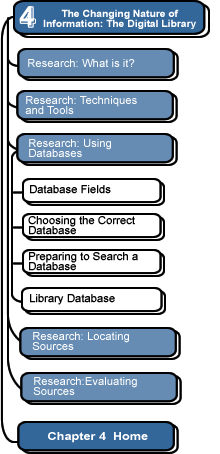

Preparing to Search a Database
You now know that research databases are often discipline specific and contain hundreds of thousands of citation or full-text articles. You also know how to select the appropriate database and that databases contain fields such as the author field, title field, and language field, to facilitate retrieval of material. In this section, we will discuss efficient searching. You will learn how to retrieve—from thousands of records—just those sources that will assist in creating your research project.
Visualize a database as nearly an infinite hallway with nearly an infinite number of doors. Each door represents a search statement. The content behind each door represents all the citations or full-text articles that will spill out if the door is opened. Some doors represent very broad searches, i.e., "religion" or "congress", and thousands of citations will spill out if these doors are opened. Other doors will reveal little because they represent inappropriate searches, i.e., searching for "divorce" in an education database. Still other doors represent productive searches. When these doors are opened, useful and relevant sources will be revealed. Your task is to find the best door(s).
What follows are some tips and techniques for finding the best doors (search statements) that will lead to the most useful sources.
![]()
![]()
These pages were
written by Glenn Remelts.
and edited by Jeffrey L. Nyhoff and Nancy Zylstra
©2005 Calvin University (formerly Calvin College), All Rights Reserved
If you encounter technical errors, contact computing@calvin.edu.